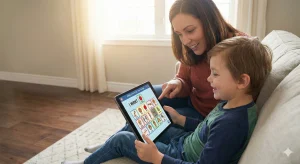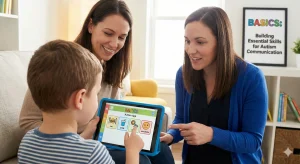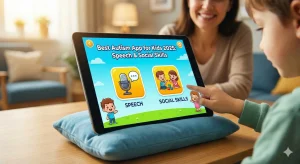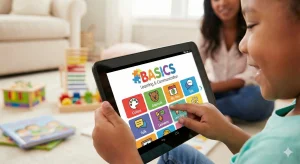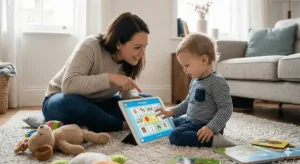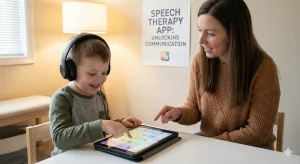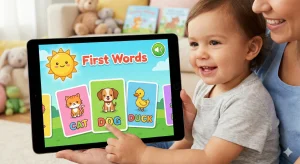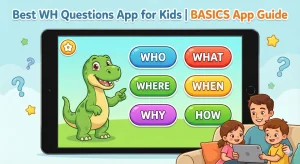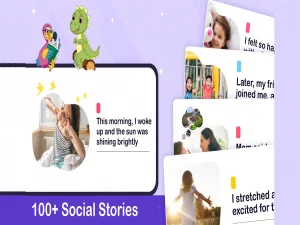Top R Words Speech Therapy Activities for Kids
Last Updated: September 3, 2024
If your child is struggling to pronounce the R sound, you’re not alone. The R sound is one of the trickiest for many kids to master, and it often requires specific attention in speech therapy. Children might replace the R sound with other sounds or distort it, leading to frustration for both the child and the parent. This challenge is common, but with the right approach, it can be effectively addressed.
Speech therapy plays a crucial role in helping kids overcome these challenges. The R sound is complex because it involves precise tongue positioning and muscle coordination. Without guidance, children might develop habits that are hard to break. That’s where targeted activities come in. These exercises are designed to improve articulation and build the skills necessary for clear and confident pronunciation of R words.
Understanding the R Sound in Speech Therapy
The R sound is one of the most complex sounds for children to master, and it’s often one of the last sounds to develop correctly. Unlike other sounds, the R sound doesn’t have a single, consistent position in the mouth, making it more challenging for kids to grasp. The tongue’s placement, the way it moves, and the shape of the mouth all play crucial roles in producing a clear R sound. This complexity can lead to a variety of speech issues, making it a focal point in speech therapy.
Common speech issues related to the R sound include distortion, where the R is produced incorrectly, often sounding like a W, and substitution, where a different sound replaces the R altogether. These issues are not just frustrating for the child but can also affect their confidence and social interactions. Early intervention is key. The sooner these challenges are addressed, the easier it is to correct them and prevent long-term speech difficulties.
Practice is equally important. Regular, targeted exercises can help children learn the correct tongue positioning and mouth movements needed to produce a clear R sound. Whether in a structured therapy setting or at home, consistent practice helps reinforce the skills necessary for improvement.
Benefits of R Words Speech Therapy
Targeted speech therapy for the R sound does more than just improve pronunciation—it can significantly boost a child’s confidence. When a child struggles with the R sound, they may feel self-conscious, especially when their peers begin to notice the difference. Correcting this sound through specific exercises helps them speak more clearly, reducing frustration and enhancing their self-esteem. As they hear their own progress, their confidence naturally grows, leading to more active participation in conversations both at home and in school.
The long-term benefits of mastering the R sound extend well beyond clear speech. Pronouncing R words correctly is crucial for effective communication, and it lays the groundwork for future language development. When a child successfully learns this sound, they are better equipped to handle other speech challenges that might arise. Moreover, mastering the R sound early on can prevent the need for more intensive speech therapy later, saving time, effort, and potential stress.
Improved communication skills are another major benefit of R words speech therapy. Being able to articulate thoughts clearly is essential in building relationships, performing well academically, and expressing emotions effectively. Children who can confidently pronounce the R sound are more likely to engage in social interactions, participate in class discussions, and express themselves without hesitation. These positive communication experiences contribute to overall development, making speech therapy a worthwhile investment for any child facing challenges with the R sound.
Top R Words Speech Therapy Activities for Kids
Helping your child master the R sound can be both fun and effective with the right activities. Below are some tried-and-true techniques that make learning engaging and manageable for kids.
a. Visual and Auditory Cues
One of the most effective ways to teach the R sound is through visual and auditory cues. Using a mirror, children can watch how their tongue moves and where it needs to be placed to make the correct sound. This visual feedback is powerful because it helps them understand the mechanics of producing the R sound. Additionally, using videos or audio recordings allows children to hear how the sound is made, reinforcing what they see. Combining these two cues creates a holistic learning experience that can significantly improve pronunciation.
b. Syllable Practice
Breaking down R words into manageable syllables is another effective strategy. Instead of tackling the entire word at once, focus on syllables like “ar,” “er,” and “or.” This approach simplifies the process, allowing children to concentrate on one part of the sound at a time. Over time, as they become more confident, you can start combining these syllables into full words, making the transition to correct pronunciation smoother and less intimidating.
c. Minimal Pairs Practice
Minimal pairs practice is a classic technique used in speech therapy. By focusing on word pairs that differ only by the R sound, such as “right” and “light,” children can learn to distinguish and produce the R sound more accurately. This method not only sharpens their listening skills but also highlights the importance of correct articulation, as even a small difference in sound can change the meaning of a word entirely.
d. Storytelling and Reading
Incorporating storytelling and reading into your child’s routine is a natural way to reinforce the R sound. Choose books and stories rich in R words, and encourage your child to read them aloud. Storytelling allows them to practice in a context that feels less like a lesson and more like fun. Plus, it gives them the opportunity to use the R sound in sentences, further solidifying their progress.
e. Games and Activities
Learning through play is always effective, especially for younger children. Games like scavenger hunts or flashcards can make practicing the R sound enjoyable. For instance, you could create a scavenger hunt where your child has to find objects that start with the R sound. This not only makes practice fun but also helps them associate the sound with everyday objects, making the learning more practical and memorable.
f. Articulation Drills
Finally, regular articulation drills are essential for mastering the R sound. Practicing common R words like “rain,” “rabbit,” and “run” through repetition drills helps build muscle memory. These drills can be done daily and don’t have to take much time. Even a few minutes of focused practice can make a significant difference in how quickly your child improves.
Also read: Top L Words for Effective Speech Therapy
Common R Words for Practice
| R Sound Position | Word | Syllables | Practice Tip |
|---|---|---|---|
| Initial R Sound | Rain | Rain | Emphasize the “R” sound by using visual aids like pictures of rain or drawing raindrops. |
| Rabbit | Rab-bit | Break the word into syllables, focusing on the “Rab” sound first, then “bit.” Use a toy rabbit for a fun association. | |
| Red | Red | Pair the word with color objects (e.g., red blocks) to reinforce the sound. | |
| Run | Run | Use a physical activity like running to connect the action with the sound. | |
| Rocket | Rock-et | Create a paper rocket and say the word each time you launch it. | |
| Medial R Sound | Carrot | Car-rot | Use a carrot or a picture of one to highlight the “rrot” sound. Break it down by syllable. |
| Berry | Ber-ry | Practice by holding up or drawing berries, focusing on the “rry” sound. | |
| Pirate | Pi-rate | Role-play as pirates, emphasizing the “rate” sound with a fun “Arrr” theme. | |
| Forest | For-est | Discuss forests, focusing on the “or” sound. Use nature-themed activities. | |
| Parrot | Par-rot | Use a toy or picture of a parrot to reinforce the sound. Break it into “Par” and “rot.” | |
| Final R Sound | Car | Car | Use minimal pairs (Car vs. Tar) to practice hearing and pronouncing the difference. |
| Star | Star | Practice with star-shaped objects, emphasizing the final “R” sound. | |
| Bear | Bear | Use stuffed bears to connect the word with the object, focusing on the final sound. | |
| Guitar | Gui-tar | Pretend to play a guitar while pronouncing the word, emphasizing the final sound. | |
| Chair | Chair | Use a chair as a prop while practicing the word, focusing on the final “R” sound. |
Tips for Parents and Therapists
When it comes to helping children master the R sound, parents and therapists play a crucial role. The right approach can make all the difference, turning what might seem like a challenge into a rewarding journey. Here are some practical tips to keep in mind:
1. Consistency is Key
Regular practice is essential for progress in speech therapy, particularly with the R sound. It’s important to make practice a daily habit, both in therapy sessions and at home. Consistency helps reinforce what your child learns, making it easier for them to remember and apply those skills. Whether it’s a quick five-minute drill or a more extended session, the key is to keep it regular. Over time, this consistent effort will lead to noticeable improvements in pronunciation.
2. Positive Reinforcement
Children respond well to positive reinforcement, and it’s a powerful tool in speech therapy. Offering praise, rewards, or even simple encouragement can go a long way in motivating your child to keep practicing. Celebrate the small wins—whether it’s correctly pronouncing a difficult R word or making it through a session without frustration. This positive feedback boosts their confidence and makes them more likely to engage actively in their therapy.
3. Involve the Child
Involving your child in the process can make therapy more engaging and effective. Let them choose their favorite R words to practice or pick the games they want to play during sessions. When children feel they have a say in their learning, they’re more likely to participate enthusiastically. This involvement also helps tailor the therapy to their interests, making practice sessions something they look forward to rather than a chore.
4. Patience and Progress Tracking
Patience is vital when working on speech therapy. Progress might be slow at times, but it’s important to remember that every child moves at their own pace. Tracking progress can help both you and your child see how far they’ve come, which can be incredibly encouraging. Whether it’s through a chart, journal, or app, monitoring improvement helps keep everyone motivated and focused on the end goal.
Also Read: Master R Blends: Fun Activities and Easy Tips for Kids
Common Challenges and Solutions
Even with the best efforts, working on the R sound can present a few challenges. Knowing how to address these obstacles can make a big difference in your child’s progress. Let’s explore some common difficulties and practical solutions that can help overcome them.
a. Difficulty in Isolating the R Sound
One of the most common challenges children face is isolating the R sound. This sound is particularly tricky because it doesn’t have a single, consistent placement in the mouth, making it harder to produce correctly. A helpful strategy is to slow down speech during practice sessions. Encourage your child to break down words into smaller parts and focus on the R sound individually. Using tactile cues, like having your child feel the movement of their tongue against the roof of their mouth, can also be effective. These techniques help your child become more aware of how to shape their mouth and position their tongue to make the correct sound.
b. Inconsistency in Pronunciation
It’s not uncommon for children to pronounce the R sound correctly in one context but struggle in another. This inconsistency can be frustrating, but it’s a normal part of the learning process. To reinforce correct pronunciation across different contexts, consider integrating R sound practice into various daily activities. For example, practice R words during playtime, mealtime, or while reading a book together. This varied approach helps children apply what they’ve learned in a range of situations, strengthening their ability to consistently pronounce the R sound correctly.
c. Lack of Motivation
Keeping children motivated during speech therapy can be challenging, especially if progress seems slow. Making practice sessions fun and engaging is key to maintaining their interest. Incorporate games, rewards, and activities that your child enjoys. For instance, turn practice into a game with points or small prizes for correctly pronouncing R words. Involving their favorite toys or characters in the exercises can also make the experience more enjoyable. The goal is to create a positive and encouraging environment where your child looks forward to practice, rather than seeing it as a chore.
Conclusion
Mastering the R sound requires time, patience, and a structured approach. By engaging in fun activities, using visual and auditory cues, and maintaining regular practice, parents and therapists can significantly enhance a child’s R sound pronunciation. These methods not only make the learning process enjoyable but also boost a child’s confidence and communication abilities. Remember, every child progresses at their own pace, so it’s crucial to stay supportive and patient. With consistent encouragement and the right strategies, your child can effectively overcome challenges with the R sound. For additional tips and expert guidance, consider exploring resources available at Wellness Hub to support your child’s speech therapy journey.
Frequently Asked Questions:
1. What are effective activities for improving the R sound in speech therapy?
Effective activities include using visual and auditory cues, practicing syllables, working with minimal pairs, engaging in storytelling, playing games, and conducting regular articulation drills.
2. Why is the R sound so difficult for children to pronounce?
The R sound is challenging because it requires precise tongue placement and muscle coordination, which can vary depending on the word. This complexity often makes it one of the last sounds children master.
3. How can I help my child practice the R sound at home?
You can help by incorporating R sound activities into daily routines, such as reading books with R words, playing pronunciation games, and using mirrors to show how the sound is made.
4. How long does it take for a child to master the R sound?
The time it takes can vary depending on the child’s age, consistency in practice, and individual challenges. Regular practice and patience are key to progress.
5. What should I do if my child is struggling with the R sound despite practice?
If your child is struggling, consider seeking support from a speech therapist who can provide targeted exercises and techniques. Wellness Hub offers resources and expert advice to guide you through this process.
6. Can speech therapy for the R sound be fun for kids?
Yes! By incorporating games, stories, and interactive activities, practicing the R sound can be both fun and effective for children.
7. What role do parents play in speech therapy for the R sound?
Parents play a crucial role by providing consistent practice, positive reinforcement, and a supportive environment at home. Engaging in activities alongside your child can make a significant difference.
8. What are some common challenges children face with the R sound, and how can they be addressed?
Common challenges include difficulty isolating the R sound, inconsistent pronunciation, and lack of motivation. These can be addressed by slowing down speech, using tactile cues, practicing in different contexts, and making sessions fun and engaging.
9. At what age should I be concerned if my child cannot pronounce the R sound correctly?
It’s normal for children to struggle with the R sound until around the age of 6 or 7. However, if your child continues to have difficulty beyond this age, consulting a speech therapist may be beneficial.
10. How can I track my child’s progress in R sound speech therapy?
You can track progress by maintaining a journal, using a progress chart, or recording your child’s practice sessions. Noticing even small improvements can be encouraging for both you and your child.
About the Author:
Anuradha Karanam
Speech-language pathologist (7+ years of experience)
Anuradha Karanam is a skilled speech-language pathologist with over 6 years of experience. Fluent in Tamil, Telugu, Hindi, and English, she specializes in parent counseling, speech sound disorders, fluency assessment, and speech-language evaluations. Anuradha excels at working with children with developmental disorders, offering creative and effective therapy programs. Currently, at Wellness Hub, she holds a BASLP degree and is registered with the RCI (CRR No A85500). Her patience, ambition, and dedication make her a trusted expert in her field.
Book your Free Consultation Today
Parent/Caregiver Info:
Client’s Details:
* Error Message
